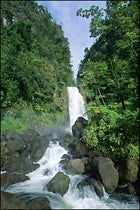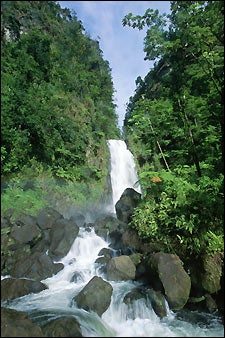When European colonizers swept through the West Indies, one of the islands that resisted them longest was Dominica, which, not coincidentally, has been one of the last holdouts against mass tourism in the Caribbean. In the ragtag little capital of Roseau, few visible signs of the outside world exist save a cruise ship dock and a Kentucky Fried Chicken outlet. Mountainous terrain and some of the rainiest real estate on earth have discouraged conquistadors and casino builders alike. But that same terrain has made it a prized destination for hikers who don’t mind getting their socks wet.

Dominica’s undersea geography is equally appealing. The diving, especially along the walls of the flooded caldera in the Scotts Head-Soufriere Marine Reserve, puts you face-to-face with soldierfish, yellowtail snappers, seafans, and rainbow runners. But the real joy comes in walking in a rainforest ridge in search of endangered Sisserou and Jacquot parrots or discovering waterfalls streaming through a hidden valley.
There’s talk of creating a trail to run the length of the 29-mile-long island. But for now, the existing paths add up to a network of day hikes. The best-known hike, an among the most demanding, is a seven-hour round trip from Titou Gorge, near the village of Laudat, to Boiling Lake, whose milky, bubbling water sometimes reaches 190-plus degrees. The walk ascends and descends a rain-slicked footpath as it takes you through steep-walled valleys so green you have expect to see Eve leaning against a tree offering you an apple. Resist the temptation: you’ll want to be free of sin when you cross the Valley of Desolation. You’ll need a guide here because the ground is unstable, and the steam that vents up through the cracks in the earth frequently makes it necessary to reroute the path.
Another popular hike is up 4,550-foot Morne Trois Pitons, the mountain with three peaks. The beginning of the trail, a third of mile past Pont Casse on the road to Castle Bruce, is signposted, but the second half of the four-hour trek to the summit of the tallest peak is less a hike than a wet scramble through matted vegetation. If you make it to the top, you may be rewarded with outstanding Caribbean views, weather permitting.
Combine a walk with a guided rowboat ride on the Indian River, near Portsmouth, at the island’s north end. The slow, mangrove-lined river is the haunt of egrets, great blue herons, and osprey. At the river’s head, while everybody else is knocking back bottles of Kabuli beer at a slapped-together bar that gets washed clean every time the water rises during heavy rains, follow the path for an easy 30-minute walk to a swimming hole with marsh and mountain views.
Precipitation is something either to endure or revel in. I recommend the latter, beneath some of the island’s waterfalls. The most spectacular is Trafalgar, 20 minutes from Roseau. The 120-foot left side of the twin falls, the “father,” is taller, but be sure to climb across the rocks and swim in the pool at the base of the “mother.” Be careful, though—the rocks are slippery enough that “mother” is not above giving her darlings a serious bruising.
If even that sounds too tame, ream up with crazy Frenchmen Michael and Eric at the adventure tour company Escape, which leads a “river hike” from November through April. It’s a walk/swim/slide that at times has you roped to your companions to keep from being swept away by the rapids. When you’re standing on a rock ledge gazing into a waterfall pool and they tell you it’s OK, go ahead and jump—though you’ll wish you could remember a prayer or two. But afterwards, when you’re back in Roseau sipping a Kalubi and watching rainbows form over the mountains, you’ll probably consider planting a flag of your own.
The Details
American Eagle flies to Dominica twice daily from San Juan. Rent a car from Wide Range Car Rentals in Roseau ($50-$70 per day; 767.448.2198), which provides free airport pickup and drop-off.
The island’s trails can be tricky, so guides are often necessary—you’ll pay about $50-$75 per person per day. One of the more patient guides, Francis Frampton, works out of Castaways Beach Hotel (888.227.8292). Amiable dreadlocked guide Bobby Frederick operates Ras Tours (767.448.0412). For river hiking, whitewater rafting, tubing, and rappelling, contact Escape (767.448.5210).
For digs, hikers favor Papillote Wilderness Retreat, a small lodge near Trafalgar Falls with three hot mineral pools fed by natural springs. The four double rooms and three suites have straw mats on the hardwood floors and colorfully tiled baths and showers (doubles $85-$100; 767.448.2287). The restaurant serves West Indian fare like river crayfish and stewed frog in season. Or perch 80 feet above the sea at the pleasant five-room Zandoli Inn on the largely undeveloped south coast, where you may spot a whale from your balcony (doubles, $125-$135; 767.446.3161). A 25-minute drive north of Roseau is Castaways Beach Hotel (doubles, $120; 888.227.8292) on one of the island’s few stretches of sand. The 26 seaside rooms have private baths, ceiling fans, and balconies; its dive center arranges scuba trips (two-tank dives, $65) as well as sea kayaking and whale-watching.
In general, the food on Dominica will make you wish you’d hoarded the pretzel pack from your flight. But for regional flavor try Pearl’s Cuisine in Roseau—just don’t order the local delicacy, mountain chicken, without first finding out what it is.


